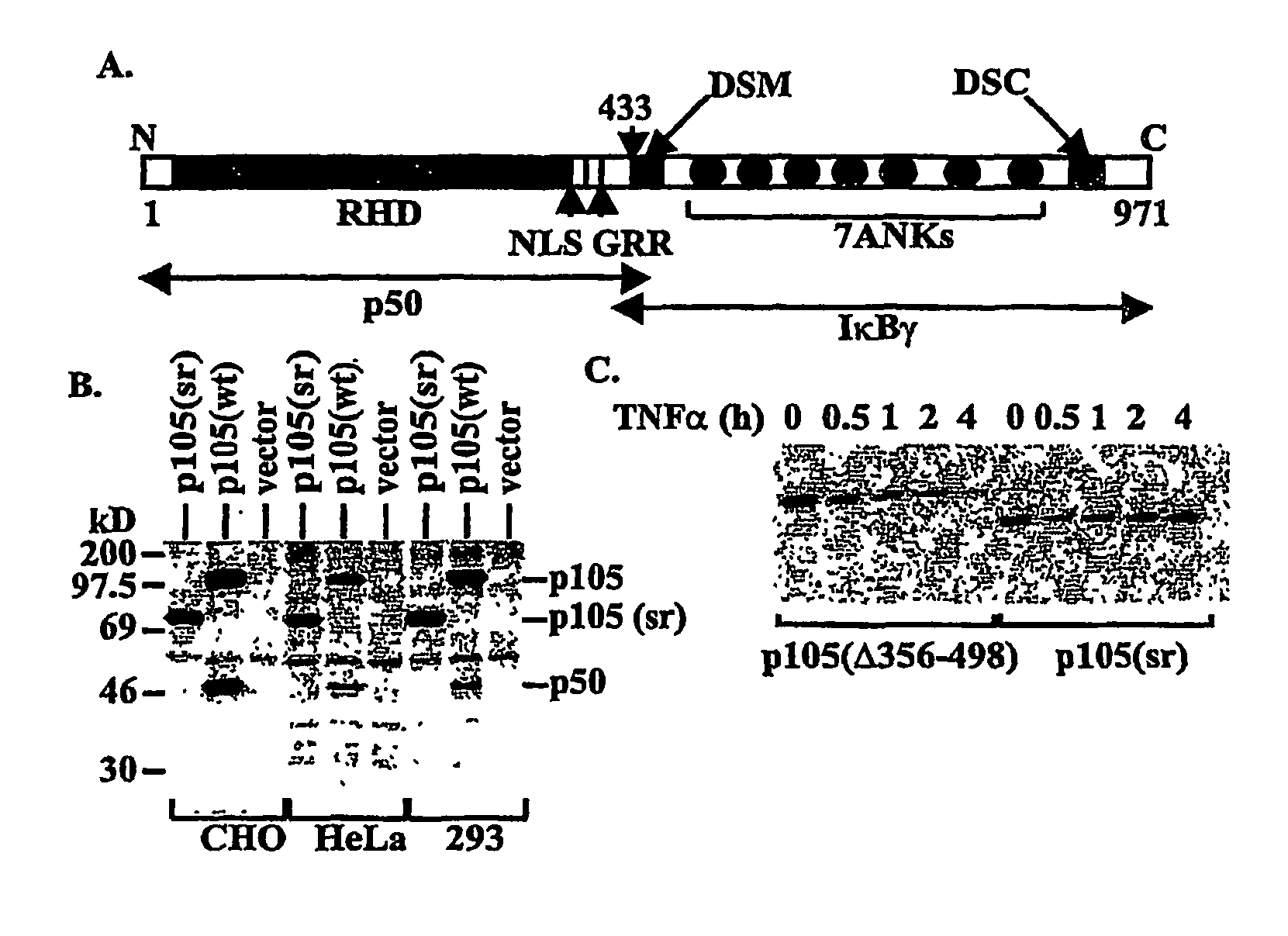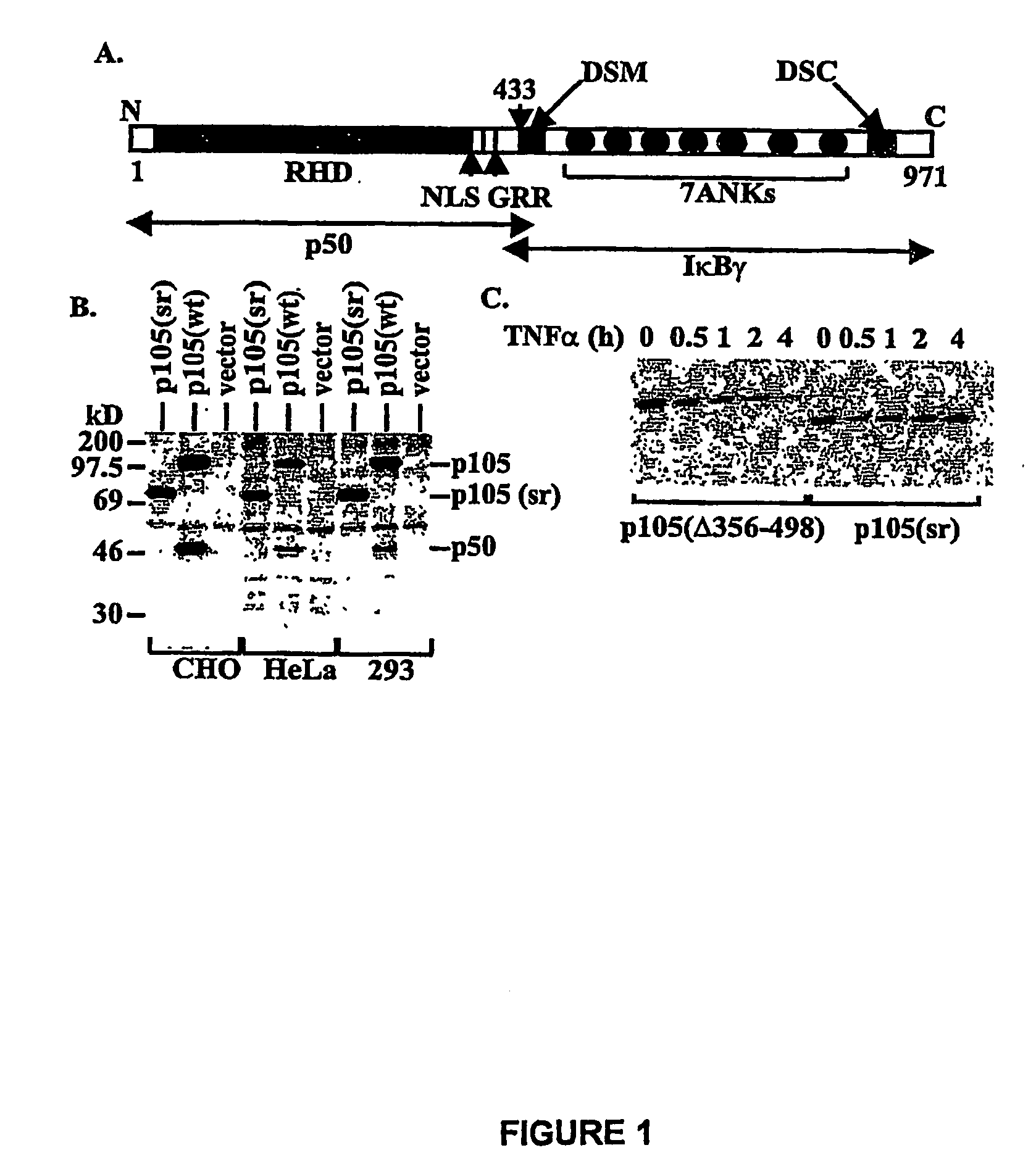Methods and compositions for inhibition of nuclear factor kappaB
a nuclear factor and composition technology, applied in the field of medicine, can solve the problem of not producing a true nf, and achieve the effect of prolonging the in vivo half-life of the repressor and similar inhibitory efficiency
- Summary
- Abstract
- Description
- Claims
- Application Information
AI Technical Summary
Benefits of technology
Problems solved by technology
Method used
Image
Examples
example 1
Construction of p105(sr)—
[0116]PCR was used to generate two deletions within murine ntkbl gene. Two sets of primers were used to generate deletion in the middle region first: 5′-CGGGATCCATGGCAGACGATG, SEQ ID NO. 9 and 5′-CCCAAGCTTTTCCTCTTTGTCTTTGATTTC (SEQ ID NO. 10) to amplify the first half of nfrkbl and 5′-GACTAGTAAGGCTCTGCAGCTCGCC (SEQ ID NO. 11) and 5′-GCTCTAGACTAAATTTTGCCTTCAATAGG (SEQ ID NO. 12) to amplify the second half of the gene. The DNA fragments were cloned into the expression vector pEVRF, with a blunted Hind III site from the first fragment directly ligated to the uncut 5′-end of the second fragment to preserve the correct reading frame. The above plasmid was then used as the template, and the primers 5′-CGGGATCCATGGCAGACGATG (SEQ ID NO. 13) and 5′-GGAATTCGGATCCTGGTAGTATATCATCAG (SEQ ID NO. 14) were used for PCR. The PCR fragment was subsequently cloned into a modified pEVRF that attaches a 12-residue epitope tag from the bacterial phage T7 gene 10 protein at the N-t...
example 2
Cell Culture Aid Transfection
[0117]Human embryonic kidney 293 cells, human cervical carcinoma HeLa cells, Chinese hamster ovary cells with a stably transfected human CD14 surface marker (CHO-CD14), and several mouse skin cell lines were used in the studies. HeLa and 293 cells were cultured in Dulbecco's modified Eagle's medium supplemented with 10% fetal bovine serum, 2 mM L-glutamine, and antibiotics and CHO-CD14 cells in RPM1640 medium with the same supplements. The cells were seeded in either 24- or 6-well plates and transfected with LipofectAMINE (Invitrogen) according to the manufacturer's instructions. Skin papilloma cell line MTI / 2, carcinoma line CH72T4 (spindle cell carcinoma), and the control keratinocyte line C50 were cultured in minimum essential Eagle's medium with Earle's balanced salt solutions supplemented with 4% (for MT1 / 2) or 1% (for C50 and CH72T4) fetal bovine serum, L-glutamine, antibiotics, and other growth supplements. The skin cells were transfected with FuG...
example 3
Measurement of Protein Concentration
[0118]A Bio-Rad protein concentration kit was used according to the manufacturer's instructions, with bovine serum albumin as the standard.
PUM
| Property | Measurement | Unit |
|---|---|---|
| diameter | aaaaa | aaaaa |
| diameter | aaaaa | aaaaa |
| size | aaaaa | aaaaa |
Abstract
Description
Claims
Application Information
 Login to View More
Login to View More - R&D
- Intellectual Property
- Life Sciences
- Materials
- Tech Scout
- Unparalleled Data Quality
- Higher Quality Content
- 60% Fewer Hallucinations
Browse by: Latest US Patents, China's latest patents, Technical Efficacy Thesaurus, Application Domain, Technology Topic, Popular Technical Reports.
© 2025 PatSnap. All rights reserved.Legal|Privacy policy|Modern Slavery Act Transparency Statement|Sitemap|About US| Contact US: help@patsnap.com



